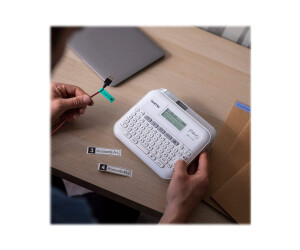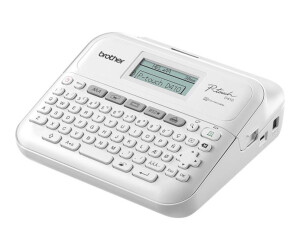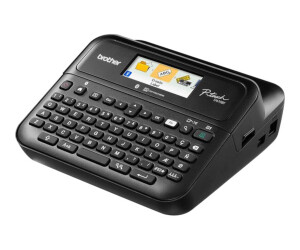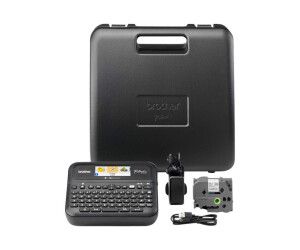







Labeling devices are practical tools that are frequently used in offices, stores, and other facilities. These devices allow users to create labels, tags, and other labels on various surfaces. The category description for labeling devices includes various aspects, including features, applications, and properties.
Features: Labeling devices offer various features to make it easier for users to create labels. Some of the most important features are:
Applications: Labeling devices are used in many applications, especially in environments where the organization and labeling of items is important. Some of the most important applications of labeling devices are:
Properties: There are various properties to consider when selecting a labeling device. Some of the most important properties include:
Labeling devices are useful tools that are used in many different environments to label and organize objects and materials. Here are some important aspects of labeling devices:
Labeling media:
Labeling media are an important part of labeling devices since they are the medium on which the labels are printed or marked. There are different types of labeling media that are suitable for different applications.
Paper: Paper is a common labeling medium used for printing labels or signs. It is available in various sizes and colors and can be easily printed and cut. However, paper is not very durable and can be easily damaged by moisture or weather conditions.
Plastic: Plastic is a more durable labeling medium than paper and is suitable for use in harsh environments or at high temperatures. There are different types of plastics, such as polyester, polypropylene, or vinyl, which can be chosen depending on the application.
Metal: Metal labeling is durable and can be suitable for use in indoor or outdoor areas. There are different types of metal labeling, such as aluminum, stainless steel, or brass, which can be chosen depending on the application.
Textiles: Textiles can be used for labeling clothing or other textiles. There are special labeling devices designed for use on textiles that can print on various types of textiles.
Font size and style:
Font size and style are important aspects of labeling devices as they have a significant impact on the readability and appearance of the label. Some labeling devices offer various font sizes and styles to choose from, providing users with greater flexibility when creating labels.
The choice of font size depends on the size of the labeling medium. If the labeling medium is small, such as in labels or cable markings, a smaller font size should be selected to ensure that the label remains readable. For larger labeling media, such as signs or posters, larger font sizes can be used.
The font style may vary depending on the application. Some labeling devices offer a variety of font styles, such as bold, italic, or underlined, which can be selected according to the requirements of the application. It is important to choose a font style that is legible and appealing to ensure that the label is easy to recognize.
Some labeling devices also offer the ability to insert symbols or graphics into the label to make it visually appealing or convey additional information. It is important to ensure that the symbols or graphics are easily readable and compatible with the labeling medium and font size.
Durability:
The durability of labeling devices is an important aspect, especially in environments such as workshops, construction sites, or warehouses, where the device is frequently exposed to harsh conditions. It is important to choose a device that meets the requirements of the application and is robust enough to withstand the demands.
Labeling devices should be designed to meet the requirements of their application. For example, some labeling devices are designed for use in wet environments and are waterproof. Others are designed to resist shocks, dust, or dirt.
It is also important to ensure that the label itself is durable. Labeling media should be chosen to meet the requirements of their application. Some labeling media, such as vinyl, are particularly durable and can be used outdoors, while others, such as paper, are only suitable for indoor use.
Paper:
Paper is a common labeling medium used for printing labels or signs. It is readily available and comes in various sizes and colors. Paper can be easily printed and cut, making it a cost-effective and practical option for indoor use.
However, paper also has some disadvantages. It is not very durable and can be quickly damaged by moisture or weathering. This can impair the legibility of the label and affect its effectiveness.
If paper is used as a labeling medium, it is important to store it in a protected environment and shield it from moisture or direct sunlight. Paper is suitable for short-term applications, such as events or temporary labeling, but should not be used for long-term applications or outdoor use.
Plastic:
Plastic is a very durable labeling medium that is suitable for use in environments exposed to moisture, dirt, high temperatures, or abrasion. There are different types of plastics that are suitable for different applications.
For example, polyester is a plastic known for its durability and resistance to chemicals. It is suitable for use in harsh environments such as factories or chemical plants, where it may be exposed to many chemicals, moisture, and abrasion. Polypropylene is another plastic that is suitable for use in harsh environments, as it is heat resistant and also resistant to chemicals and abrasion. Vinyl is a flexible plastic that is suitable for making stickers and labels that need to be bent or applied around curves.
Plastic labeling media may be available in various colors, sizes, and thicknesses and are usually durable and water-resistant. They may also be suitable for outdoor use as they are more resistant to UV radiation and weathering than paper.
When using plastic labeling media, it is important to ensure that they are suitable for the application and that the correct type of plastic is selected for the specific requirements. Overall, plastic is a reliable and robust labeling medium suitable for use in harsh environments or at high temperatures.
Metal:
Metal is a durable and robust labeling medium that is generally suitable for use in demanding environments. There are different types of metals that can be used for making labels, such as aluminum, stainless steel, or brass.
Aluminum is a commonly used metal for making labels as it is lightweight yet durable. It may be available in different thicknesses and sizes and is usually available in a variety of colors. Aluminum labels may be suitable for outdoor use as they are more resistant to UV radiation and weathering than paper.
Stainless steel is another commonly used metal for making labels, especially for applications that require high durability and resistance to moisture and corrosion. Stainless steel labels may be available in different sizes, thicknesses, and colors.
Brass is a decorative metal known for its golden color and resistance to oxidation and corrosion. Brass labels are suitable for decorative applications or for applications where a luxurious look is desired.
Metal labels may be suitable for indoor or outdoor use and may have high durability and resistance to moisture, abrasion, and other environmental factors. When using metal labels, it is important to ensure that they are suitable for the specific application and that the correct type of metal is selected for the requirements.
Textiles:
Textiles are a versatile labeling medium that can be used to label clothing, bags, shoes, or other textiles. The labeling can consist of letters, numbers, logos, or other graphics and is usually applied to the textile through a printing process.
There are special labeling devices designed for use on textiles that can print various types of textiles. Most of these devices use a heat transfer technology where the labeling is printed on a carrier paper and then applied to the textile.
There are different types of textile labeling, such as screen printing, embroidery, or vinyl stickers. Screen printing is a method where the color is applied to the textile through a fine mesh screen. It is ideal for producing large quantities of textile labeling. Embroidery is a method where the design is applied to the textile by sewing threads. It is suitable for producing personalized clothing items. Vinyl stickers are a method where a design is cut out of vinyl film and applied to the textile. It is ideal for producing small quantities of textile labeling.
Advantages of using labeling devices:
Efficiency: Labeling devices can create labeling quickly and easily, saving time and labor.
Flexibility: Labeling devices offer a variety of options for font size, font style, and labeling media, providing great flexibility in designing and applying labeling.
Precision: Labeling devices can create precise and uniform labeling, ensuring a professional appearance.
Repeatability: Labeling devices can reproduce identical labeling quickly and easily, which can be important when a large number of labels are needed.
Cost-effectiveness: Labeling devices can reduce the cost of outsourcing labeling work as they can create labeling in-house.
Disadvantages of using labeling devices:
Cost: Labeling devices can be a significant investment and may not be affordable for all businesses or organizations.
Limited durability: Some labeling media, especially paper, are not very durable and can be easily damaged by moisture or weather conditions.
Limited size: Labeling devices may have a limited size for the media to be labeled, which can limit the application possibilities.
Learning curve: Using labeling devices may require a certain learning curve to be able to use them effectively and efficiently.
Limitations on application: Labeling devices may be limited to certain applications, for example, they may not be suitable for labeling curved or uneven surfaces.
Conclusion:
In summary, labeling devices can help improve organization and efficiency in various environments by labeling and organizing objects and materials. When selecting the right device, the requirements of the application and the properties of the labeling medium should be considered. It is important to choose a device that is robust enough to withstand the demands of its environment. Depending on the application, various media such as paper, plastic, metal, or textiles can be used. Paper is cost-effective and practical for indoor use, but has its limitations in terms of durability. Plastics and metals are more durable and suitable for use in harsh environments, while textiles can be used for labeling clothing and other textiles. Overall, labeling devices are useful tools that can help improve organization and efficiency in different environments when selected according to the requirements of the application.





| id | title | mpn | price | manufacturer |
|
from *
/ |

